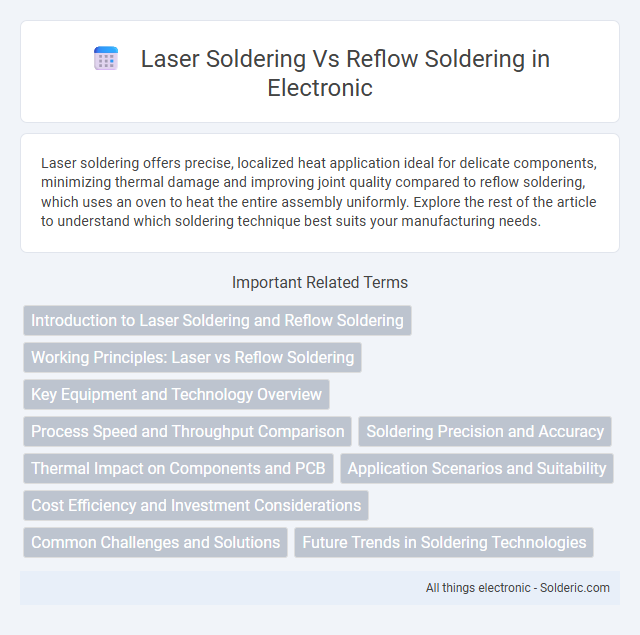Laser soldering offers precise, localized heat application ideal for delicate components, minimizing thermal damage and improving joint quality compared to reflow soldering, which uses an oven to heat the entire assembly uniformly. Explore the rest of the article to understand which soldering technique best suits your manufacturing needs.
Comparison Table
| Feature | Laser Soldering | Reflow Soldering |
|---|---|---|
| Heating Method | Focused laser beam | Convection and radiation in oven |
| Precision | High, localized heating | Uniform but less targeted |
| Process Speed | Fast, seconds per joint | Minutes per batch |
| Thermal Impact | Minimal, limited heat affected zone | Whole board heated |
| Application | Small batch, repair, precision components | Mass production, SMT assembly |
| Equipment Cost | High initial investment | Moderate to high |
| Complexity | Requires skilled operator | Standardized process |
| Suitability | Fine-pitch components, sensitive parts | Large PCB assemblies |
| Flux Use | Often flux-less or minimal flux | Flux applied with solder paste |
| Defect Rate | Low with proper control | Moderate, influenced by oven profile |
Introduction to Laser Soldering and Reflow Soldering
Laser soldering uses a focused laser beam to precisely heat solder joints, enabling rapid, localized soldering ideal for delicate components and small areas. Reflow soldering involves applying solder paste on printed circuit boards (PCBs) and then uniformly heating them in an oven to melt the solder, forming secure electrical connections across multiple components simultaneously. Both techniques play crucial roles in electronics manufacturing, with laser soldering offering targeted precision and reflow soldering providing high-throughput efficiency.
Working Principles: Laser vs Reflow Soldering
Laser soldering utilizes a focused laser beam to precisely heat the solder joint, allowing rapid localized melting with minimal thermal impact on surrounding components. Reflow soldering relies on controlled oven heating to uniformly raise the entire PCB's temperature, melting solder paste simultaneously across all joints. The laser method offers superior accuracy and reduced thermal stress, while reflow ensures consistent soldering results for mass production.
Key Equipment and Technology Overview
Laser soldering employs a focused laser beam to precisely heat and melt solder, enabling localized and rapid soldering with minimal thermal impact on surrounding components. Reflow soldering utilizes a conveyor belt oven or infrared heaters to gradually heat the entire PCB assembly, causing solder paste to melt and form joints as the board passes through controlled temperature zones. Key equipment for laser soldering includes laser sources, galvanometer scanners, and vision systems, whereas reflow soldering relies on conveyor ovens, temperature profiling tools, and flux application systems.
Process Speed and Throughput Comparison
Laser soldering offers significantly faster process speeds with precise, localized heating, enabling rapid solder joint formation and reducing thermal stress on components. Reflow soldering, while effective for mass production, generally has longer cycle times due to the need for gradual temperature ramp-up and cool-down phases across the entire PCB. Higher throughput is achievable in laser soldering for selective soldering tasks, whereas reflow soldering excels in batch processing of densely populated boards.
Soldering Precision and Accuracy
Laser soldering provides superior soldering precision and accuracy due to its focused heat source, which allows for localized heating and minimal thermal stress on surrounding components. Reflow soldering, while effective for batch processing, generally offers less precise thermal control, often resulting in uniform heating that may affect nearby parts and lead to potential solder bridging or component misalignment. The focused energy delivery of laser soldering enables detailed work on small or complex assemblies, enhancing joint reliability and reducing defects compared to the broader heat distribution of reflow soldering.
Thermal Impact on Components and PCB
Laser soldering delivers precise, localized heat to components and PCBs, minimizing thermal stress and reducing the risk of damage to sensitive parts. Reflow soldering subjects the entire PCB to elevated temperatures, which can increase thermal expansion and potentially degrade heat-sensitive components and PCB materials. Your choice between these methods should consider the thermal tolerance of components to ensure optimal assembly quality and reliability.
Application Scenarios and Suitability
Laser soldering is ideal for precision electronics, such as semiconductor packaging and micro-assembly, due to its localized heat application and minimal thermal stress. Reflow soldering suits mass production of printed circuit boards (PCBs) where uniform heating of multiple components simultaneously improves efficiency. Laser soldering excels in delicate, high-density applications, while reflow soldering is preferred for large-scale manufacturing requiring consistent throughput.
Cost Efficiency and Investment Considerations
Laser soldering offers higher cost efficiency in low to medium volume production due to its precise heat application, reducing material waste and minimizing thermal damage to components. Reflow soldering requires significant upfront investment in ovens and thermal profiling equipment but delivers faster processing speeds ideal for high-volume manufacturing. Evaluating total cost of ownership, laser soldering has lower maintenance expenses, whereas reflow soldering benefits from established process standardization and scalability.
Common Challenges and Solutions
Laser soldering and reflow soldering both face challenges such as thermal management and solder joint reliability. In laser soldering, precise control of laser power and spot size mitigates issues like substrate damage and insufficient wetting, while in reflow soldering, optimized temperature profiles and flux formulations improve solder paste activation and reduce voids. Employing real-time monitoring systems and adaptive process controls enhances quality assurance and addresses common defects in both soldering techniques.
Future Trends in Soldering Technologies
Laser soldering is increasingly favored for its precision and minimal thermal impact, enabling finer pitch components and reducing board warpage, while reflow soldering continues to evolve with advanced temperature profiling and environmentally friendly fluxes. Emerging trends highlight the integration of AI-driven monitoring and adaptive control systems to optimize solder joint quality in both laser and reflow processes. The future of soldering technologies includes greater automation, real-time process analytics, and the development of lead-free, low-temperature alloys enhancing reliability and sustainability across electronics manufacturing.
Laser soldering vs reflow soldering Infographic

 solderic.com
solderic.com